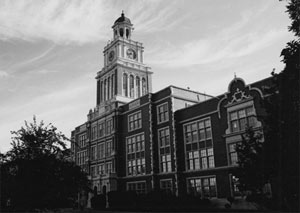National and State Register
East High School
Denver County
East High School opened in 1925 as an important part of a city campaign to modernize and beautify schools and other public buildings in keeping with the City Beautiful movement.
In its revivalist design and careful siting, East High School epitomizes the City Beautiful ethic. The building is a finely executed example of English Jacobean Revival or Jacobethan Revival style architecture as designed by the important Denver architect, George Williamson. He chose the accessible and open Jacobean style in part due to its ability to accommodate large scale window treatments considered essential to state-of-the-art educational buildings. The library interior retains a mural painted in 1934 by Hugh Weller as part of the Depression-era Public Works Art Project program.
East High is important for its role in the education of Denver’s youth during the period of 1925 to 1975, a period when East High School evolved from serving primarily well-to-do Anglo students to a school at the vanguard of race relations and school integration. The school stood as a leader and model among Denver schools in establishing formal and informal avenues for exploring and furthering the understanding of issues related to racial and ethnic diversity, becoming a nexus of Black student activism during the Civil Rights Movement from 1968 to the early 1970s. Black students led demonstrations and organized for better disciplinary systems, improved history courses on Black history, and advocated for greater numbers of Black teachers. East was also one of the schools studied during the landmark Keyes v. Denver School District No. 1 Supreme Court case that identified de facto racial segregation in Denver Public Schools.

